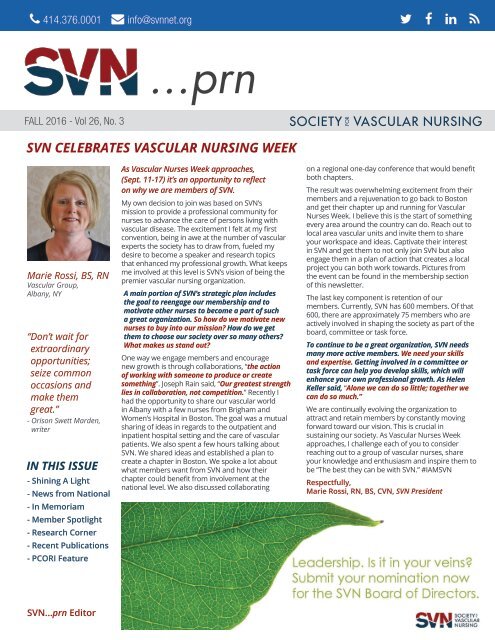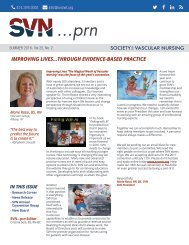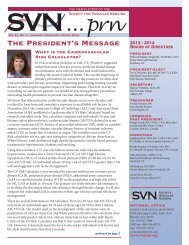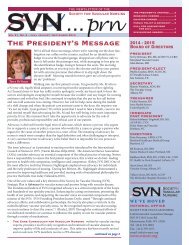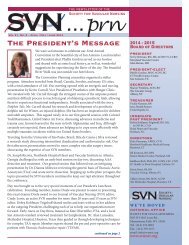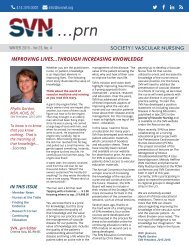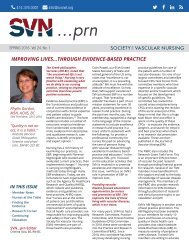SVN...prn Fall 2016 Issue
You also want an ePaper? Increase the reach of your titles
YUMPU automatically turns print PDFs into web optimized ePapers that Google loves.
414.376.0001 info@svnnet.org<br />
<br />
...<strong>prn</strong><br />
FALL <strong>2016</strong> - Vol 26, No. 3<br />
<strong>SVN</strong> CELEBRATES VASCULAR NURSING WEEK<br />
Marie Rossi, BS, RN<br />
Vascular Group,<br />
Albany, NY<br />
“Don’t wait for<br />
extraordinary<br />
opportunities;<br />
seize common<br />
occasions and<br />
make them<br />
great.”<br />
- Orison Swett Marden,<br />
writer<br />
IN THIS ISSUE<br />
- Shining A Light<br />
- News from National<br />
- In Memoriam<br />
- Member Spotlight<br />
- Research Corner<br />
- Recent Publications<br />
- PCORI Feature<br />
As Vascular Nurses Week approaches,<br />
(Sept. 11-17) it’s an opportunity to reflect<br />
on why we are members of <strong>SVN</strong>.<br />
My own decision to join was based on <strong>SVN</strong>’s<br />
mission to provide a professional community for<br />
nurses to advance the care of persons living with<br />
vascular disease. The excitement I felt at my first<br />
convention, being in awe at the number of vascular<br />
experts the society has to draw from, fueled my<br />
desire to become a speaker and research topics<br />
that enhanced my professional growth. What keeps<br />
me involved at this level is <strong>SVN</strong>’s vision of being the<br />
premier vascular nursing organization.<br />
A main portion of <strong>SVN</strong>’s strategic plan includes<br />
the goal to reengage our membership and to<br />
motivate other nurses to become a part of such<br />
a great organization. So how do we motivate new<br />
nurses to buy into our mission? How do we get<br />
them to choose our society over so many others?<br />
What makes us stand out?<br />
One way we engage members and encourage<br />
new growth is through collaborations, “the action<br />
of working with someone to produce or create<br />
something”. Joseph Rain said, “Our greatest strength<br />
lies in collaboration, not competition.” Recently I<br />
had the opportunity to share our vascular world<br />
in Albany with a few nurses from Brigham and<br />
Women’s Hospital in Boston. The goal was a mutual<br />
sharing of ideas in regards to the outpatient and<br />
inpatient hospital setting and the care of vascular<br />
patients. We also spent a few hours talking about<br />
<strong>SVN</strong>. We shared ideas and established a plan to<br />
create a chapter in Boston. We spoke a lot about<br />
what members want from <strong>SVN</strong> and how their<br />
chapter could benefit from involvement at the<br />
national level. We also discussed collaborating<br />
on a regional one-day conference that would benefit<br />
both chapters.<br />
The result was overwhelming excitement from their<br />
members and a rejuvenation to go back to Boston<br />
and get their chapter up and running for Vascular<br />
Nurses Week. I believe this is the start of something<br />
every area around the country can do. Reach out to<br />
local area vascular units and invite them to share<br />
your workspace and ideas. Captivate their interest<br />
in <strong>SVN</strong> and get them to not only join <strong>SVN</strong> but also<br />
engage them in a plan of action that creates a local<br />
project you can both work towards. Pictures from<br />
the event can be found in the membership section<br />
of this newsletter.<br />
The last key component is retention of our<br />
members. Currently, <strong>SVN</strong> has 600 members. Of that<br />
600, there are approximately 75 members who are<br />
actively involved in shaping the society as part of the<br />
board, committee or task force.<br />
To continue to be a great organization, <strong>SVN</strong> needs<br />
many more active members. We need your skills<br />
and expertise. Getting involved in a committee or<br />
task force can help you develop skills, which will<br />
enhance your own professional growth. As Helen<br />
Keller said, “Alone we can do so little; together we<br />
can do so much.”<br />
We are continually evolving the organization to<br />
attract and retain members by constantly moving<br />
forward toward our vision. This is crucial in<br />
sustaining our society. As Vascular Nurses Week<br />
approaches, I challenge each of you to consider<br />
reaching out to a group of vascular nurses, share<br />
your knowledge and enthusiasm and inspire them to<br />
be “The best they can be with <strong>SVN</strong>.” #IAM<strong>SVN</strong><br />
Respectfully,<br />
Marie Rossi, RN, BS, CVN, <strong>SVN</strong> President<br />
<strong>SVN</strong>...<strong>prn</strong> Editor
VASCULAR NURSES WEEK<br />
SEPTEMBER 11-17, <strong>2016</strong><br />
As Vascular Nurses Week approaches,<br />
(September 11-17) it’s an opportunity to<br />
reflect on why we are members of <strong>SVN</strong>.<br />
My own decision to join was based on <strong>SVN</strong>’s mission to provide a<br />
professional community for nurses to advance the care of persons<br />
living with vascular disease. The excitement I felt at my first convention,<br />
being in awe at the number of vascular experts the society has to draw<br />
from, fueled my desire to become a speaker and research topics that<br />
enhanced my professional growth. What keeps me involved at this level<br />
is <strong>SVN</strong>’s vision of being the premier vascular nursing organization.<br />
The strength and foundation of the organization can be found in YOU,<br />
its members. During this special week, I personally want to thank you for<br />
all that you do for our patients. You advance their care through research,<br />
education, and the daily provision of evidenced based clinical practice.<br />
You embody the core principles that <strong>SVN</strong> was founded on in 1982.<br />
We are continually evolving the organization to attract and retain<br />
members by constantly moving forward toward our vision. As Vascular<br />
Nurses Week approaches, I challenge each of you to consider reaching<br />
out to a group of vascular nurses, share your knowledge and enthusiasm<br />
and inspire them to be “The best they can be with <strong>SVN</strong>.” Join the global<br />
celebration and share your story/passion/love for job during Vascular<br />
Nursing Week by using the hashtag #IAM<strong>SVN</strong>.<br />
Thank you for passion and commitment in advancing the care of<br />
persons living with vascular disease!<br />
Marie Rossi<br />
<strong>SVN</strong> President
Shining a Light on Vascular Nursing:<br />
A Teaching Moment<br />
Successful Case Study on How to Implement Vascular Nurses Week<br />
Activities at Your Institution.<br />
Brigham and Women’s Hospital<br />
Cardiovascular Unit; Boston, MA<br />
Fernanda Trevisone, RN-BC, BSN,<br />
BA; Anabelen Contreras, RN, BSN,<br />
BS; Karen Hanrahan, RN, BSN, BS;<br />
Denise Fay, RN, BSN<br />
HOW IT ALL BEGAN<br />
Recognizing vascular nursing at<br />
Brigham and Women’s Hospital,<br />
Jeanne Doyle, the founder of the<br />
Society of Vascular Nursing, was a<br />
catalyst in obtaining the Governor<br />
of Massachusetts to proclaim<br />
the second week of June 2014 as<br />
Vascular Nurse’s Week. With the<br />
support and encouragement of<br />
our nursing leadership and as a<br />
highly trained specialty area at a<br />
large academic medical center,<br />
we sought to celebrate and<br />
educate the public about issues<br />
surrounding vascular disease.<br />
HOW IT CAME TO FRUITION<br />
With only less than a week to<br />
prepare for our event, we quickly<br />
gathered a group of nurses<br />
to take on this endeavor. We<br />
designed posters about vascular<br />
diseases, a “Getting To Know”<br />
staff poster, we scavenged for<br />
educational pamphlets on PVD/<br />
PAD, Diabetes, AAA, smoking<br />
cessation, high blood pressure,<br />
carotid artery stenosis, healthy<br />
eating, etc. In addition, we visited<br />
our vascular clinic and medical<br />
library for models and textbooks<br />
to display. We reached out to our<br />
vascular surgeons and invited<br />
them to visit our tabling event.<br />
Some provided us with actual<br />
stents, grafts, IVC filters and<br />
business cards.<br />
We petitioned and received an<br />
additional proclamation from the<br />
mayor of Boston. Our Nursing<br />
Director, Alice O’Brien, was very<br />
supportive and increased the staff<br />
on the day of the event so that<br />
everyone could participate and be<br />
part of the celebration.<br />
EVENT SUMMARY<br />
Tables located in a high traffic<br />
area of the hospital were set up<br />
containing a variety of pamphlets,<br />
models, handouts and giveaways.<br />
Patients, visitors and hospital staff<br />
were among those who visited<br />
the event. We provided doppler<br />
pulse checks and blood pressure<br />
screenings with one blood<br />
pressure reading leading to an<br />
Emergency Department referral.<br />
Teaching was a big component of<br />
the day! We found that many of<br />
the people who stopped by had<br />
very good questions regarding<br />
vascular disease. Many people<br />
shared personal stories of their<br />
own experiences.<br />
RESULTS<br />
Not only do we feel this event<br />
increased collaboration and<br />
relationship between doctors and<br />
nurses, but ultimately the patients<br />
and visitors were very grateful<br />
and appreciated the education.<br />
Other departments in the hospital<br />
expressed their wishes to be<br />
included in future Vascular<br />
Nurse’s Week celebrations.<br />
We became involved with the<br />
Society of Vascular Nursing and<br />
submitted an abstract for the <strong>SVN</strong><br />
Conference Poster Presentations<br />
to showcase our event. We<br />
were thrilled to find out that our<br />
abstract had been accepted. Due<br />
to the overwhelming positive<br />
response from patients, staff and<br />
visitors, we created a committee<br />
to focus on making a collaborative<br />
annual event.<br />
www.svnnet.org
News<br />
From National<br />
VASCULAR NURSES WEEK<br />
SEPTEMBER 11-17, <strong>2016</strong><br />
<strong>SVN</strong> Receives<br />
Educational Grant<br />
<strong>SVN</strong> received an educational grant from<br />
Gore to support the advancement of <strong>SVN</strong>’s<br />
educational strategic priorities including:<br />
technology improvements for <strong>SVN</strong> online<br />
learning modules, launching the <strong>SVN</strong> Vascular<br />
Nursing Tool Kit and Wound Care Learning<br />
Modules, expanding nursing and patient<br />
education resources and training and<br />
developing podcasts.<br />
View the <strong>SVN</strong> thank you video on the<br />
<strong>SVN</strong> YouTube Channel here.<br />
Vascular Nurses Week:<br />
September 11-17<br />
Celebrate Vascular Nursing Week,<br />
September 11-17, <strong>2016</strong>. North Carolina and<br />
Indiana have formally declared this week as<br />
Vascular Nursing Week. Public Policy Chair,<br />
Patty Flanagan has applied to 36 states and<br />
the White House requesting them to make<br />
the same proclamation.<br />
Visit www.svnnet.org for resources and ideas<br />
on how to celebrate this special week.<br />
<strong>SVN</strong> Launches<br />
Donation Platform<br />
<strong>SVN</strong>’s mission is to advance the care of persons<br />
living with vascular disease and now you have<br />
the opportunity to join the cause. There are a<br />
number of ways to show your support for the<br />
nurses working tirelessly to provide a better<br />
quality of life for those affected by vascular<br />
disease. By contributing to the Mission<br />
Advancement, 35th Anniversary Celebration<br />
or Memorial/Tribute campaign, you’ll help<br />
ensure that our work continues.<br />
Learn more.<br />
<strong>SVN</strong> October Board Meeting<br />
The <strong>SVN</strong> Board will be meeting for a strategic<br />
planning session in Albany, NY on October 9-11.<br />
The board will host an inaugural Meet and Greet:<br />
An Evening with the Vascular Presidents event.<br />
The event will be co-hosted by <strong>SVN</strong> President,<br />
Marie Rossi and Society for Vascular Surgeons<br />
President-Elect Dr. Clem Darling.<br />
www.svnnet.org
In Memoriam<br />
Jane C. Frasca<br />
April 16, 1939 - July 28, <strong>2016</strong><br />
It is with a very heavy heart that<br />
I write to let you know of the<br />
recent death of Jane Frasca. She<br />
passed away peacefully on July<br />
28, surrounded by her family. She<br />
is survived by her husband of 56<br />
years, Tom, their three children and<br />
spouses, and 7 grandchildren.<br />
Jane was a vascular nurse clinician<br />
at New England Deaconess Hospital<br />
(currently Beth Israel Deaconess<br />
Medical Center) in Boston, MA for<br />
many years. In her lengthy career,<br />
she taught many nurses and<br />
physicians about compassionate<br />
care of patients with vascular<br />
disease.<br />
Jane was the inaugural recipient<br />
of the Jeanne E. Doyle Award in<br />
Toronto in 1987, served on <strong>SVN</strong>’s<br />
Board of Directors, and served as<br />
Society President from 1994-1995.<br />
Jane’s active leadership helped to<br />
shape the mission and vision of<br />
<strong>SVN</strong> in our formative years, and she<br />
remained committed to the Society<br />
for more than 30 years. She was so<br />
full of life and her wonderful sense<br />
of humor and infectious laugh<br />
brought smiles to so many of us.<br />
I have heard from many of you<br />
and want to share the sentiments<br />
of Past President’s Patty Lewis,<br />
Carolyn Robinson, and Mitzi Ekers,<br />
who captured Jane’s essence so<br />
eloquently:<br />
“I will always remember Jane as a<br />
kind and witty woman who was a<br />
devoted nurse and very dedicated<br />
to <strong>SVN</strong>. She was absolutely thrilled<br />
to be asked back to the Board after<br />
her retirement, even expressing<br />
astonishment that the Society<br />
would want her back ‘at my age.’<br />
Her smile and positive personality<br />
brought warmth and sincerity to<br />
any encounter.”<br />
– Patty Lewis<br />
“Jane was one of my idols in <strong>SVN</strong>. I<br />
was the one that very much wanted<br />
her to rejoin the Board that year<br />
she agreed to come back. I had<br />
met her when she was President<br />
and I was so impressed by her<br />
Presidential presentation. This<br />
is a great loss to <strong>SVN</strong>. She was a<br />
wonderful woman!!”<br />
- Carolyn Robinson<br />
“Jane was so full of life and laughter.<br />
Every time I think of Jane, a smile<br />
spreads across my face. A word<br />
she used often when describing<br />
someone or some crazy event was<br />
“It was such a HOOT!” Well Jane<br />
Frasca was such a HOOT, keeping<br />
us in tears of laughter as she told<br />
incredible stories of situations<br />
only she could get herself into.<br />
From the height of hilarity to the<br />
depths of her endless compassion<br />
for patients, friends, family and<br />
everyone she met; that was Jane<br />
and I will miss her dearly. So much<br />
of what <strong>SVN</strong> is today is because of<br />
her enthusiastic efforts.”<br />
- Mitzi Ekers<br />
Jane was my convention “hotel<br />
roommate” for 20+ years and we<br />
often talked into the wee hours<br />
of the morning about <strong>SVN</strong>, family<br />
and life in general. I attended the<br />
celebration of her life mass on<br />
Saturday, August 13, and during his<br />
eulogy, her son Scott spoke of how<br />
much <strong>SVN</strong> meant to her!<br />
In this 35th <strong>SVN</strong> anniversary year,<br />
I respectfully ask you to consider<br />
making a donation to the Society<br />
in Jane’s memory. She would be<br />
so honored to be remembered<br />
in this special way.<br />
With sadness but a heart full of<br />
fond memories,<br />
Jeanne Doyle<br />
Founding President, <strong>SVN</strong> (1982-1986)<br />
Memorial<br />
Donations<br />
click here<br />
www.svnnet.org
MEMBERSHIP corner<br />
Collaboration at the Albany<br />
Vascular Center in Albany, NY.<br />
Collaboration picture taken at the Albany<br />
Vascular Center in Albany, NY. The vascular<br />
group angio suite had nurses from the inpt<br />
and outpt side angio nurses C6 and M5<br />
nurses and their CNS and PA.<br />
Left to Right Marie Rossi,Murniyati<br />
Rapsen,Anabelen Contreras,Karen<br />
Hanrahan, Karen Fitzgerald<br />
Murniyati Rapsen from Sinapore<br />
with Marie Rossi<br />
Keith Ware from Rooke
SAVE THE DATE<br />
35 th ANNUAL CONVENTION<br />
APRIL 4-7, 2017<br />
Loews Vanderbilt Nashville, Tennessee<br />
ANNIVERSARY
Research Corner<br />
STATISTICAL SIGNIFICANCE AND CLINICAL SIGNIFICANCE<br />
By: Kathleen Rich, PhD, RN, CCNS,<br />
CCRN-CSC, CNN<br />
Cardiovascular Clinical Specialist<br />
La Porte Hospital<br />
Merriam-Webster’s dictionary defines<br />
“significance” as the quality of being<br />
important or having notable worth or<br />
influence. 1 Nurses consider evidencebased<br />
practice (EBP) as the foundation<br />
upon which care is delivered. Research<br />
is one of the cornerstones supporting<br />
EBP. In quantitative research, (also<br />
known as the scientific method) there<br />
is typically objective gathering of<br />
numeric information by some type of<br />
formal measurement tool. 2 Quantitative<br />
research study results are described as<br />
statistically significant. Study findings<br />
are publicized as being clinically<br />
significant. What is the difference<br />
between statistical significance and<br />
clinical significance?<br />
Statistical significance measures how<br />
likely that any apparent differences in<br />
the observed results between treatment<br />
and control groups are real and not due<br />
to chance. Statistical tests are designed<br />
to test hypotheses (or research<br />
questions) in quantitative research. One<br />
of the most commonly used measures<br />
in all statistical tests is the probability<br />
or p-value. In statistics, a p-value helps<br />
you determine mathematically the<br />
significance of your results. A p-value<br />
ranges from 0 to 1. Many researchers<br />
select a small p-value (< 0.05) as the<br />
cut-off indicator number indicating<br />
statistically significant findings. This<br />
translates into the results obtained<br />
were probably true. Simplistically, this<br />
means that only 5 times out of 100 the<br />
obtained results would be false. 2<br />
Clinical significance (also known as<br />
clinical importance) is related to the<br />
practicality of the study findings. Clinical<br />
significance measures how large the<br />
differences in treatment effects are<br />
in clinical practice. Basically, is the<br />
difference between the new treatment<br />
and the old treatment found in the<br />
study substantial enough to alter your<br />
practice? There is no one single method<br />
to determine clinical significance.<br />
Examining confidence intervals instead<br />
of significance levels is one method.<br />
Confidence intervals show the range of<br />
results within where the value is likely<br />
to lie. For example, a study showed<br />
a statistically significant impact (p <<br />
0.02) of the effects of music therapy<br />
on reducing systolic BP compared to<br />
controls. The mean reduction was 7 mm<br />
Hg (95% CI 4, 10). Instead of significance<br />
testing telling us that this study result<br />
could have occurred 2% of the time by<br />
chance alone (the p < 0.02), confidence<br />
intervals tell us what our best guess<br />
is for the size of the population effect;<br />
95% of the time. Other statistics that<br />
may be used to assist in determining<br />
clinical significance are calculating the<br />
number needed to treat and relative risk<br />
reduction. 4<br />
However, statistics are only an assist<br />
in determining clinical significance.<br />
The practitioner must utilize clinical<br />
judgment when considering the benefit<br />
magnitude and side effects between the<br />
two treatments. 5 The financial impact<br />
to the healthcare institution, clinician<br />
and patient (especially if it is a longterm<br />
therapy) must also be considered.<br />
Clinical significance encompasses not<br />
only statistical significance, but the<br />
importance of evaluating the outcomes<br />
to patients, clinicians, healthcare<br />
institutions and policymakers.<br />
Reference:<br />
1. Merriam-Webster Dictionary.<br />
Merriam-Webster, Inc. 2015. Available<br />
at: http://www.merriam-webster.com/<br />
dictionary/significance. Accessed<br />
7-29-16.<br />
2. Polit, D., Beck, C. Essentials of nursing<br />
research (7th Ed). 2010. Philadelphia:<br />
Wolters Kleuwer/Lippincott Williams<br />
& Wilkins<br />
3. Burns, N., Grove, S. Understanding<br />
nursing research (5th Ed). 2011.<br />
Philadelphia: Elsevier Saunders.<br />
4. Leung, D. Balancing statistical and<br />
clinical significance in evaluating<br />
treatment effects. Postgrad Med J<br />
2001; 77: 201-204.<br />
5. Brignardello-Petersen, R., Carrasco-<br />
Labra, A., Azarpazhooh, A. A<br />
practitioner’s guide to developing<br />
critical appraisal skills: what is the<br />
difference between clinical and<br />
statistical significance? J Am Dent<br />
Assoc 2013; 144(7): 780-786.<br />
www.svnnet.org
Recent<br />
PUBLICATIONS<br />
ABrekelmans MP, Bleker SM,<br />
Bauersachs R, et al. Clinical impact<br />
and course of major bleeding<br />
with edoxaban versus vitamin K<br />
antagonists. Thromb Haemost. <strong>2016</strong><br />
Mar 24;116(1).<br />
Cahill K, Lindson-Hawley N, Thomas<br />
KH, et al. Nicotine receptor partial<br />
agonists for smoking cessation.<br />
Cochrane Database Syst Rev. <strong>2016</strong> May<br />
9;5:CD006103.<br />
Ennis H, Hughes M, Anderson ME,<br />
et al. Calcium channel blockers for<br />
primary Raynaud`s phenomenon.<br />
Cochrane Database Syst Rev. <strong>2016</strong> Feb<br />
25;2:CD002069.<br />
Gajic-Veljanoski O, Phua CW, Shah<br />
PS, et al. Effects of Long-Term<br />
Low-Molecular-Weight Heparin on<br />
Fractures and Bone Density in Non-<br />
Pregnant Adults: A Systematic Review<br />
With Meta-Analysis. J Gen Intern Med.<br />
<strong>2016</strong> Feb 19.<br />
Karlson BW, Palmer MK, Nicholls SJ,<br />
et al. A VOYAGER Meta-Analysis of<br />
the Impact of Statin Therapy on Low-<br />
Density Lipoprotein Cholesterol and<br />
Triglyceride Levels in Patients With<br />
Hypertriglyceridemia. Am J Cardiol.<br />
<strong>2016</strong> Feb 17. pii: S0002-9149(16)30224-7.<br />
Martinelli I, Lensing AW, Middeldorp<br />
S, et al. Recurrent venous<br />
thromboembolism and abnormal<br />
uterine bleeding with anticoagulant<br />
and hormone therapy use. Blood. <strong>2016</strong><br />
Mar 17;127(11):1417-25.<br />
Rothwell PM, Algra A, Chen Z, et<br />
al. Effects of aspirin on risk and<br />
severity of early recurrent stroke<br />
after transient ischaemic attack and<br />
ischaemic stroke: time-course analysis<br />
of randomised trials. Lancet. <strong>2016</strong> May<br />
18. pii: S0140-6736(16)30468-8.<br />
Salisbury C, O`Cathain A, Thomas<br />
C, et al. Telehealth for patients at<br />
high risk of cardiovascular disease:<br />
pragmatic randomised controlled trial.<br />
BMJ. <strong>2016</strong> Jun 1;353:i2647.<br />
Sandberg K, Kleist M, Falk L, et al.<br />
Effects of Twice-Weekly Intense Aerobic<br />
Exercise in Early Subacute Stroke: A<br />
Randomized Controlled Trial. Arch<br />
Phys Med Rehabil.<br />
<strong>2016</strong> Feb 19.<br />
Semlitsch T, Jeitler K, Berghold A, et al.<br />
Long-term effects of weight-reducing<br />
diets in people with hypertension.<br />
Cochrane Database Syst Rev. <strong>2016</strong> Mar<br />
2;3:CD008274.<br />
Stewart S, Wiley JF, Ball J, et al.<br />
Impact of Nurse-Led, Multidisciplinary<br />
Home-Based Intervention on Event-<br />
Free Survival Across the Spectrum of<br />
Chronic Heart Disease: Composite<br />
Analysis of Health Outcomes in 1226<br />
Patients From 3 Randomized Trials.<br />
Circulation. <strong>2016</strong> May 10;133(19):<br />
1867-77.<br />
Uchiyama S, Ishizuka N, Shimada K,<br />
et al. Aspirin for Stroke Prevention in<br />
Elderly Patients With Vascular Risk<br />
Factors: Japanese Primary Prevention<br />
Project. Stroke. <strong>2016</strong> Jun;47(6):1605-11.<br />
Williamson JD, Supiano MA, Applegate<br />
WB, et al. Intensive vs Standard Blood<br />
Pressure Control and Cardiovascular<br />
Disease Outcomes in Adults Aged<br />
>/=75 Years: A Randomized Clinical<br />
Trial. JAMA. <strong>2016</strong> May 19.<br />
Wong GW, Boyda HN, Wright JM Blood<br />
pressure lowering efficacy of beta-1<br />
selective beta blockers for primary<br />
hypertension. Cochrane Database Syst<br />
Rev. <strong>2016</strong> Mar 10;3:CD007451.<br />
____________________________________<br />
Janice D. Nunnelee PhD RN<br />
Practice and Research Committee<br />
414.376.0001 info@svnnet.org
PCORI feature<br />
LOOKING FOR A FEW ‘GOOD’ VASCULAR PATIENTS<br />
— OR THEIR CAREGIVERS<br />
“Researcher” is often synonymous<br />
with PhDs, academics, scientists,<br />
and clinicians. But the definition of<br />
‘researcher’ is expanding to include<br />
a new type of collaborator— the<br />
Patient Advisor.<br />
“Researcher” is often synonymous<br />
with PhDs, academics, scientists,<br />
and clinicians. But the definition of<br />
‘researcher’ is expanding to include<br />
a new type of collaborator— the<br />
Patient Advisor.<br />
“Not only do individual patients<br />
know what’s right for their own<br />
health, they often have insights<br />
that can help patients with similar<br />
conditions get better care,”<br />
says Adrienne Faerber, PhD, Associate<br />
Director of Academic Affairs, MHCDS,<br />
and lecturer at The Dartmouth Institute,<br />
who is leading a new collaborative to<br />
cultivate Patient Advisors to advance<br />
vascular research and care.<br />
The collaboration of The Dartmouth<br />
Institute for Health Policy and Clinical<br />
Practice, Society for Vascular Surgery,<br />
The Society for Vascular Nursing and the<br />
Patient-Centered Outcomes Research<br />
Institute (PCORI) will train patients or<br />
their caregivers in principles of vascular<br />
medicine, clinical research, and the<br />
skills necessary to be a Patient Advisor,<br />
including how to review patientcentered<br />
research proposals and share<br />
their personal experiences. Following<br />
the course, the project will connect<br />
Patient Advisors with researchers to<br />
foster new-patient centered research<br />
projects.<br />
The collaborative is asking <strong>SVN</strong><br />
members to help identify and recruit<br />
vascular patients or their caregivers<br />
for the project, in keeping with <strong>SVN</strong>’s<br />
mission to promote excellence in clinical<br />
practice, education and research to<br />
advance vascular care.<br />
“Help us get the word out in the vascular<br />
community about this opportunity for<br />
vascular patients to become partners in<br />
research by sharing their experiences in<br />
a highly focused and meaningful way,”<br />
Faerber said.<br />
Designed to allow participants to work<br />
at their own pace, the online course<br />
will cover three topics: foundations of<br />
vascular medicine, principles of patientcentered<br />
outcomes research, and<br />
how to collaborate with researchers.<br />
Participants will watch videos, read<br />
articles, and engage in activities to<br />
reinforce the weekly material.<br />
Participants should have experience<br />
with vascular disease, be Internet-savvy,<br />
with regular access to e-mail, and be<br />
curious and insightful.<br />
Upon completion of the course, patient<br />
advisors will be able to apply for a<br />
grant to attend the Society for Vascular<br />
Surgery’s Annual Meeting scheduled for<br />
June of 2017 in San Diego, Calif.<br />
For more information, visit<br />
PatientAdvisorsCourse.com.<br />
414.376.0001 info@svnnet.org
600 Members<br />
Founded<br />
in 1982<br />
Demographics<br />
55% of <strong>SVN</strong> members<br />
are educationally<br />
prepared at the<br />
baccalaureate<br />
level or higher<br />
25% hold<br />
masters degrees<br />
3% are prepared at<br />
the doctoral level<br />
55%<br />
25%<br />
3%<br />
Mission:<br />
To provide a professional<br />
community for nurses focused<br />
on advancing the care of<br />
persons living with vascular<br />
disease through excellence<br />
in evidence based practice<br />
and education.<br />
74%<br />
Members work<br />
in a wide variety<br />
of vascular patient<br />
care roles:<br />
74% provide direct<br />
patient care in<br />
collaboration with<br />
their vascular surgeons<br />
and vascular medicine<br />
physicians;<br />
12% 12% are in education<br />
5% 5% are in research.<br />
3 Publications<br />
• Journal of Vascular Nursing<br />
• Core Curriculum for<br />
Vascular Nursing<br />
• Scope and Standards of<br />
Vascular Nursing Practice<br />
Patient Resources<br />
7 Patient Education Booklets<br />
6 Patient Education Fact Sheets<br />
4 Online Education Courses<br />
2 Position Statements<br />
16<br />
Chapters<br />
2015 launched the <strong>SVN</strong> Dare to<br />
Make A Difference Challenge to<br />
increase social media engagement<br />
8 Collaborative Partnerships<br />
712 Facebook Likes<br />
34 years of Annual Conventions<br />
674 Twitter Followers<br />
26 Certified Ankle-Brachial<br />
Index Trainers<br />
Over 9,000 website visitors monthly<br />
12 States proclaim 2nd week of<br />
September as Vascular Nurses Week<br />
N83 W13410 Leon Road, Menomonee <strong>Fall</strong>s, WI 53051<br />
414-376-0001 • info@svnnet.org • www.svnnet.org
REGISTER TODAY!<br />
SEPT<br />
18 -22, <strong>2016</strong><br />
WYNN LAS VEGAS<br />
GLOBAL<br />
LIVE CASES<br />
MULTISPECIALTY<br />
EDUCATION<br />
FELLOWS<br />
PROGRAM<br />
VIRTUAL<br />
PARTICIPATION<br />
Witness the most<br />
challenging cases from<br />
around the globe<br />
Leading experts from<br />
over 35 countries representing<br />
all vascular specialties<br />
U.S. physicians-in-training<br />
attend complimentary and present<br />
at a world-class conference<br />
Interaction with VIVA faculty and<br />
attendees, resources, presentations<br />
and other conference tools<br />
Come early for The VEINS!<br />
September 17-18, <strong>2016</strong><br />
WWW.VIVAPHYSICIANS.ORG<br />
@VIVAPhysicians<br />
#VIVAPVD<br />
THE GLOBAL EDUCATION COURSE FOR VASCULAR MEDICINE AND INTERVENTION


